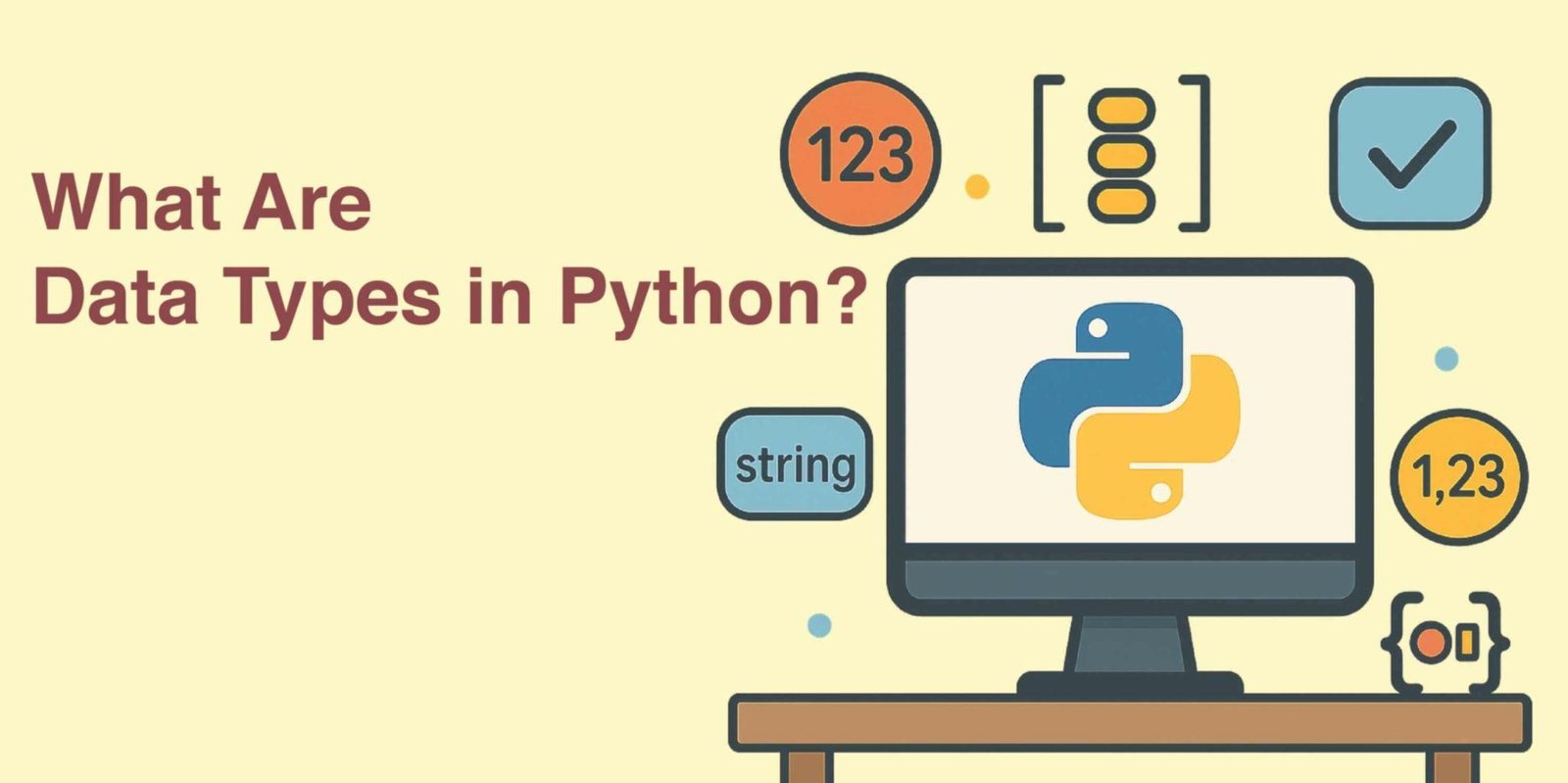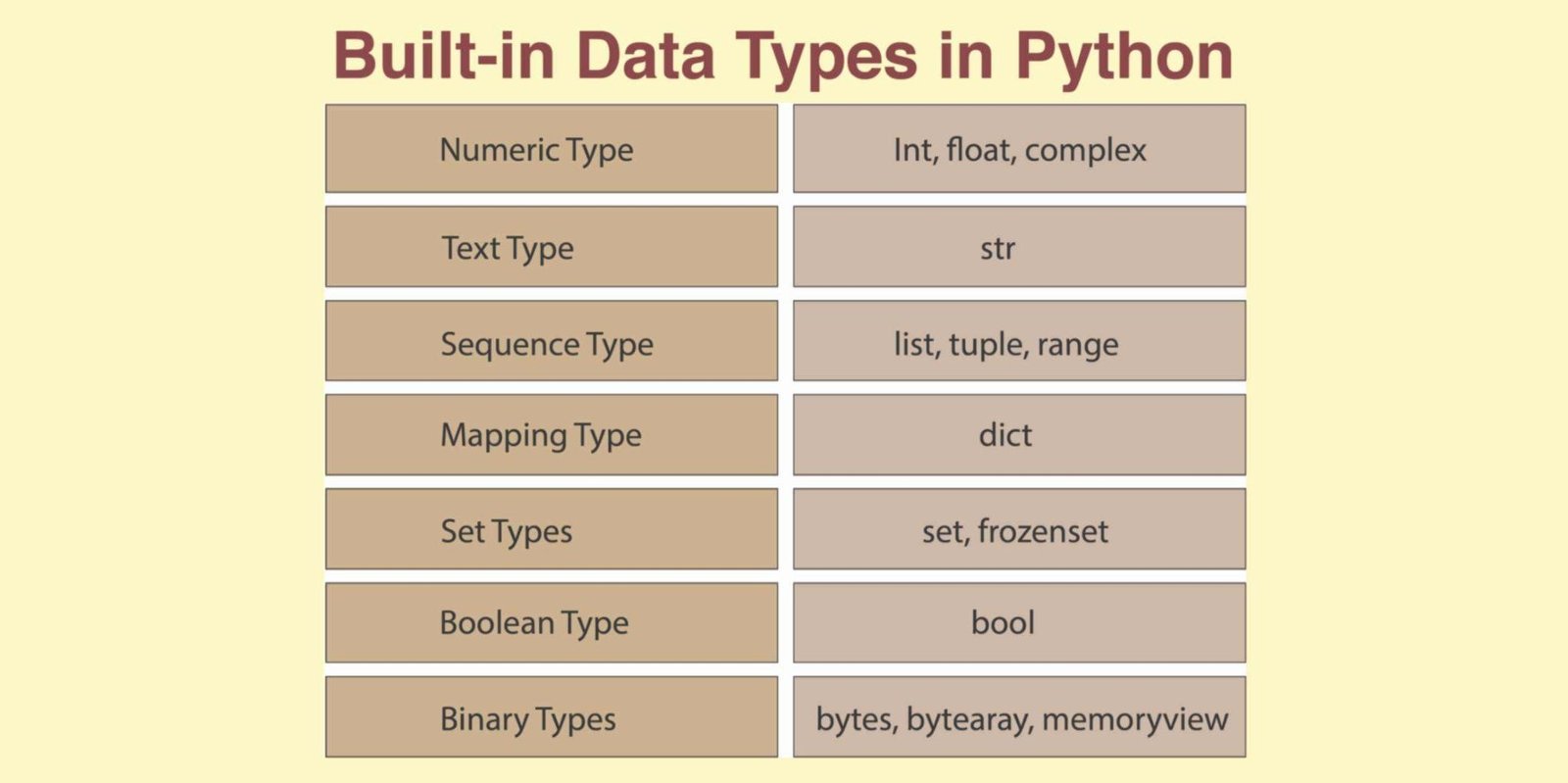What are Data Types in Python?

Data types are the fundamental building blocks of any programming language. Data Types in Python determine the kind of value a variable holds and the operations that can be performed on it. Python offers a rich collection of built-in data types, making it easy to handle various data types efficiently. Understanding data types in Python is crucial for writing clean, effective, and error-free code.
Introduction to Python Data Types
Imagine organising your kitchen: you use different containers for rice, oil, and spices based on their nature. Similarly, in programming, data types serve as containers to hold various data types. Unlike statically typed languages such as C or Java, Python uses dynamic typing. This means you don’t have to explicitly declare a variable's data type; Python determines it during runtime.
Dynamic typing offers flexibility but demands a firm grasp of data types to avoid bugs and ensure the code behaves as expected. Python variable types are automatically assigned, but developers must still choose appropriate data types for operations and memory management.
Why Data Types Matter in Python Programming
Incorrect handling of data types can lead to runtime errors. For instance, adding a string and an integer directly will raise a TypeError. Consider this example:
x = "10"
y = 5
print(x + y) # TypeError
Such mistakes can hinder performance and cause logical errors. Additionally, choosing the correct data type improves memory efficiency. For example, using a tuple instead of a list for fixed collections conserves memory.
Knowing Python's basic data types enables developers to write optimized, scalable, and more readable code. It also facilitates easier debugging and smoother integration with external data sources or APIs.
Built-in Data Types in Python

Python classifies its built-in data types into several broad categories:
Numeric types: int, float, complex
Text type: str
Sequence types: list, tuple, range
Mapping type: dict
Set types: set, frozenset
Boolean type: bool
Binary types: bytes, bytearray, memoryview
Each type serves a specific purpose and supports various operations tailored to its nature. Let’s delve into each category.
1. Numeric Data Types
Python supports three numeric data types:
int: Whole numbers, e.g., x = 10
float: Decimal numbers, e.g., y = 3.14
complex: Numbers with a real and imaginary part, e.g., z = 2 + 3j
a = 10
b = 3
print(a + b) # 13
print(a / b) # 3.333...
print(a ** b) # 1000
Python also provides built-in functions like abs(), round(), and the math modules for more complex calculations.
2. Text Data Type: String
Strings in Python are sequences of Unicode characters enclosed in quotes:
message = "Hello, Python!"
Common string operations:
print(message[0]) # H
print(message[0:5]) # Hello
print(message.lower()) # hello, python!
Useful string methods:
split(): Splits a string into a list
join(): Joins elements of a list into a string
replace(): Replaces part of a string
3. Sequence Data Types
Python provides three main sequence types:| Features | List | Tuple |
|---|---|---|
| Mutable | Yes | No |
| Syntax | [1, 2, 3] | (1, 2, 3) |
| Use case | Dynamic Data | Fixed Data |
range() is often used in loops and generates a sequence of numbers.
for i in range(5):
print(i) # 0 to 4
4. Mapping Data Type: Dictionary
Dictionaries store key-value pairs: student = {"name": "Alice", "age": 20}
Common Operations:
print(student["name"]) # Alice
print(student.get("age")) # 20
student["age"] = 21
print(student.keys()) # dict_keys(['name', 'age'])
Dictionaries are ideal for fast lookups and structured data.
5. Set Data Types
Sets store unique, unordered items: fruits = {"apple", "banana", "cherry"}
Set Operations:
set1 = {1, 2, 3}
set2 = {3, 4, 5}
print(set1 | set2) # Union
print(set1 & set2) # Intersection
print(set1 - set2) # Difference
FrozenSet is an immutable version of set.
6. Boolean Data Type
Booleans represent truth values:
is_valid = True
is_active = False
They are crucial in conditions:
if is_valid and is_active: print("Access granted")
Comparison operators like ==, !=, >, < return boolean values.
7. Binary Data Types
Used for handling binary data such as files or network packets:bytes: Immutable sequences
bytearray: Mutable sequences
memoryview: Access the internal data of objects
b = bytes([65, 66, 67])
print(b) # b'ABC'
Type Conversion in Python
Implicit conversion:
x = 5
y = 2.0
z = x + y # float
Explicit conversion:
s = "100"
n = int(s) # string to int
Improper type conversion can raise errors, so it should be used with care.
Checking Data Types in Python
Use type() to find a variable’s data type:
x = 10
print(type(x)) # Use isinstance() for type checking:
print(isinstance(x, int)) # True
This helps validate inputs and debugging.
Conclusion
Understanding the various types of data in Python is essential for every developer. From managing memory efficiently to avoiding runtime errors, knowing how and when to use Python's basic data types enhances code quality and performance.
Python’s dynamic typing makes it accessible, but developers must also be vigilant about variable types and conversions. Mastering these concepts builds a solid foundation for advanced programming, whether working with numeric data types, strings, or complex data structures like dictionaries and sets.
To deepen your knowledge, enrol in Bhrighu Academy’s hands-on Python courses and explore practical applications of data types in real-world projects.
Take the next step in your programming journey with Bhrighu Academy today!
Frequently Asked Questions
What is a tuple?
A tuple in Python is an ordered, immutable sequence that stores multiple items. Defined using parentheses, e.g., (1, 2, 3), it is ideal for fixed collections. Unlike lists, tuples cannot be modified after creation, making them more memory-efficient and suitable for read-only data.
What is an array?
Like some other languages, Python does not have a built-in array type. However, lists are commonly used as dynamic arrays. The array module or NumPy library is preferred for numerical arrays. Arrays store multiple values in one variable and are useful for mathematical and data operations.
Which is faster, a list or a tuple?
Tuples are generally faster than lists in Python because they are immutable and require less memory. Since their contents can't change, operations like iteration are quicker. Mutable Lists offer flexibility but have slightly slower performance due to additional memory and processing overhead.
What is immutable in Python?
Immutable types in Python are data types whose values cannot be changed after creation. Examples include int, float, str, and tuple. Any operation on these types creates a new object instead of modifying the original, ensuring data integrity and enabling safer code in multi-threaded environments.






